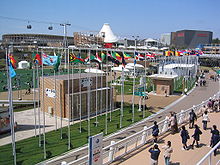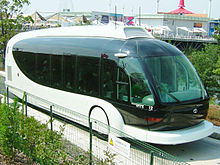Expo 2005
| Expo 2005 愛 知 万博 , Aichi bampaku |
|
|---|---|

|
|
| motto | "Shizen no Eichi 自然 の 叡智 , wisdom of nature" |
| General | |
| Exhibition space | 173 hectares |
| new hits | ASIMO |
| Number of visitors | 22,049,544 |
| BIE recognition | Yes |
| Website | http://www.expo2005.or.jp/en/ |
| participation | |
| countries | 121 countries |
| Place of issue | |
| place | Aichi prefecture |
| terrain |
Seto and Nagakute coordinates: 35 ° 10 ′ 34.2 " N , 137 ° 5 ′ 26.5" E |
| calendar | |
| opening | March 25, 2005 |
| closure | September 25, 2005 |
| Chronological order | |
| predecessor | Expo 2000 |
| successor | Expo 2008 |
The World Exhibition Expo 2005 ( Jap. 愛知万博 , Aichi bampaku ) took place from 25. March bis 25. September 2005 in the Japanese prefecture of Aichi instead. The central Expo site was in Nagakute Municipality, east of Nagoya , with further exhibitions in Seto City .
Expo 2005 was the fifth International Exhibition in Japan after the Universale Expo '70 in Osaka , the Specialized Expo '75 in Okinawa , the Specialized Expo '85 in Tsukuba and the International Horticultural Exhibition '90 in Osaka.
history
Nagoya had applied to host the 1988 Summer Olympics , but the South Korean capital, Seoul , won the bid . Then the idea arose to use this area for a world exhibition. In 1997, Japan was awarded the contract to host Expo 2005.
Originally, the planning was based on a total of 25 million visitors. After the bad experience of the Expo 2000 in Hanover , the forecast was reduced to 15 million visitors, which in the end was exceeded by far.
Motto and name
The motto of the expo was Shizen no Eichi ( 自然 の 叡智 , wisdom of nature ).
The Expo had the nickname Ai Chikyū-Haku ( 愛 ・ 地球 博 , love - world exhibition ) in the logo . In this play on words , the names of the organizer prefecture Aichi merged with the words Ai ("love") and Chikyū ("earth, world").
Pavilions and attractions
The Nagakute site was 185 hectares and featured the following attractions:
- Global loop
- Global Commons
- Central zone
- Japan zone
- Company pavilions
- Interactive amusement zone
- Forest adventure zone
Automatic buses drove across the site in Nagakute, and visitors could also take a cable car from the northern to the southern part of the exhibition. Another cable car connected the two Expo locations in Nagakute and Seto.
On the much smaller site in Seto (15 hectares) there were the pavilions of Japan and Aichi Prefecture as well as a citizens' pavilion.
Visitors
number
Before the start of Expo 2005, the organizers were expecting 80,000 visitors a day, on peak days ( Golden Week , summer holidays) up to 150,000 and a total of around 15 million visitors.
However, only 43,000 people came on the opening day and 46,000 people on the second day, which was probably due to the unusually cold weather. In April the number of visitors was usually around 40,000 to 50,000 per day, on weekends up to 80,000. A first peak was reached on April 23 with 112,332 visitors, another record followed in Golden Week on May 4 with 149,214 people. In May and June the number of visitors was an average of 110,000 per day, the peak days here were May 28 with 153,112 visitors and June 18 with 171,860 people. The ten millionth visitor was counted on July 4th. The daily number of visitors in July and August was mostly between 80,000 and 130,000.
A total of 22,049,644 people visited Expo 2005, which significantly exceeded the organizers' corrected forecasts and was close to the original expectations.
distribution
Surveys showed that around half of the visitors had come to the Expo more than once by mid-August. About 50% of the visitors came from the three prefectures of Aichi, Mie and Gifu , and 22% from the Kantō region (at the beginning of the expo only 10% of the visitors came from Kantō).
Only 5% of the visitors were foreigners, mostly from South Korea , Taiwan , the People's Republic of China and the USA . This was a disappointment for the organizers, who had expected 10% foreign guests.
Others
At the official opening ceremony of Expo 2005, an orchestra with musicians from all over the world (“Super World Orchestra”) played the classic piece “I'll Be Your Love” written especially for the occasion by Yoshiki, the leader of the band X-Japan . Yoshiki conducted the orchestra himself.
For fear of terrorist attacks and possible food poisoning, extensive security checks were carried out at the beginning of the Expo 2005 to ensure that no drinks and food from outside reached the site. However, after strong protests against this regulation, especially from school classes and schools, in the first few weeks, the Expo management lifted this ban at the request of Prime Minister Junichiro Koizumi .
The area after the end of the expo
Immediately after the expo ended, extensive demolition and renovation work began on the site. Almost all of the attractions and pavilions were demolished and the site was transformed into a park, which opened under the name Ai Chikyū-Haku Kinen Koen ( 愛 ・ 地球 博 記念 公園 ) on July 15, 2006 and has been operated by Aichi Prefecture ever since . Further construction work was carried out until 2010.
Picture gallery
"Humanoid" robot ASIMO
Web links
- Expo 2005. Bureau International des Expositions (English). Retrieved March 24, 2017 .
- Official homepage of the Expo 2005 (English). Accessed July 18, 2007.
Individual evidence
- ↑ Official site of BIE, Japan (eng) , accessed December 12, 2016







